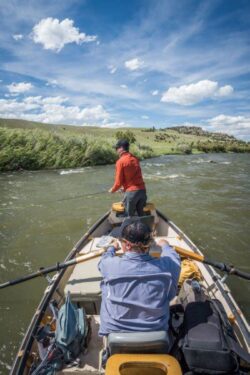You haven’t seen Montana until you have seen it from the back of a horse or the bow of a drift boat. Fishing from a drift boat has great views and advantages. These high bowed boats are perfect for what they are designed to do. Drifters can navigate rough currents and rapids safely while allowing anglers to fish standing up.
Rowing a drift boat is an acquired skill you need to learn how to row backwards. In a regular lake rowboat, you are not facing where you are going. You row towards where you plan to go. On a river, you are facing where you are going, in a downstream current, full of rocks, rapids and obstacles, while rowing upstream to slow and control your drift. If you don’t understand this skill, hire an oarsman to mentor you. I have had afternoon guide days where all I did was teach how to back up the boat trailer, launch the boat, row the boat, and load the boat. All these skills are essential to drifting Montana and western rivers. 
Kanting a drift boat is also important. Anglers need to be able to reach the shore, or place where they are casting. The boat needs to be moving slightly slower than the current. Canting means that the boat is slightly angled from the shore. When moving across current to adjust the boats position or change banks, your path will also be angled, or Kanted.
Clearing the decks is important. Most rods get busted from being stepped on or when the boat is in motion. The rule is that if the boat is moving, passengers are seated or have their legs securely in the stations. Live vests are also a great idea. You can wear small, compact vests which are unobtrusive. Enclosed rod holders are a good idea. Having pre rigged rods stored securely allows an angler to quickly change rods from a surface fly to a nymph rig using rod holders. 
Having a throw bag is important if someone goes overboard. One fisherman set the hook so hard, in the back station, that they walked out the back of the boat. A quick toss of a throw bag gave him something to hang onto as the boat is quickly beached. In this case, they also held onto the rod and landed the fish. Enter and exit the boat from the rower’s station amidships.
Know the drift before you float it. Use maps and visit the take outs before you do the trip. Hang a ribbon on a tree to show the location. Take a GPS map navigation reading. In some cases, islands or channels may obstruct the takeout view. Going back upstream is not an option.
When stopping your boat, announce the upcoming shore or anchor release. NEVER anchor in the mainstream current. The drift boat can easily sink by the stern and flood the boat and passengers. Anchor off to the side of moving water. Also anchor when beached. Changing flows and wind can launch the beached boat before you can catch it. Anchors of around 4o pounds work best. Light anchors tend to drag the bottom. Never secure the anchor line to the boat. If an emergency happens let the anchor line, go. 
If you are not alert, you will get hurt! Booze, drugs, and distractions will increase risks. Save the booze for back at the campsite or lodge. Focus on fishing rather than being stupid!
Drift safely and smartly!
Montana Grant
Credit: Source link































